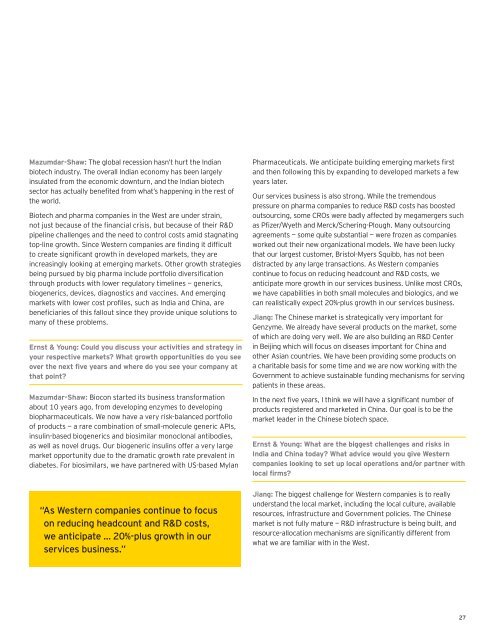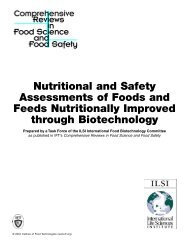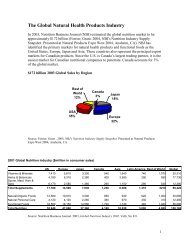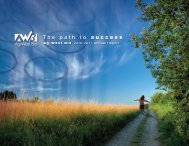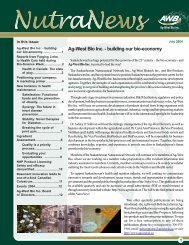Beyond Borders: Global biotechnology report 2010
Beyond Borders: Global biotechnology report 2010
Beyond Borders: Global biotechnology report 2010
Create successful ePaper yourself
Turn your PDF publications into a flip-book with our unique Google optimized e-Paper software.
Mazumdar-Shaw: The global recession hasn’t hurt the Indian<br />
biotech industry. The overall Indian economy has been largely<br />
insulated from the economic downturn, and the Indian biotech<br />
sector has actually benefited from what’s happening in the rest of<br />
the world.<br />
Biotech and pharma companies in the West are under strain,<br />
not just because of the financial crisis, but because of their R&D<br />
pipeline challenges and the need to control costs amid stagnating<br />
top-line growth. Since Western companies are finding it difficult<br />
to create significant growth in developed markets, they are<br />
increasingly looking at emerging markets. Other growth strategies<br />
being pursued by big pharma include portfolio diversification<br />
through products with lower regulatory timelines — generics,<br />
biogenerics, devices, diagnostics and vaccines. And emerging<br />
markets with lower cost profiles, such as India and China, are<br />
beneficiaries of this fallout since they provide unique solutions to<br />
many of these problems.<br />
Ernst & Young: Could you discuss your activities and strategy in<br />
your respective markets? What growth opportunities do you see<br />
over the next five years and where do you see your company at<br />
that point?<br />
Mazumdar-Shaw: Biocon started its business transformation<br />
about 10 years ago, from developing enzymes to developing<br />
biopharmaceuticals. We now have a very risk-balanced portfolio<br />
of products — a rare combination of small-molecule generic APIs,<br />
insulin-based biogenerics and biosimilar monoclonal antibodies,<br />
as well as novel drugs. Our biogeneric insulins offer a very large<br />
market opportunity due to the dramatic growth rate prevalent in<br />
diabetes. For biosimilars, we have partnered with US-based Mylan<br />
“As Western companies continue to focus<br />
on reducing headcount and R&D costs,<br />
we anticipate … 20%-plus growth in our<br />
services business.”<br />
Pharmaceuticals. We anticipate building emerging markets first<br />
and then following this by expanding to developed markets a few<br />
years later.<br />
Our services business is also strong. While the tremendous<br />
pressure on pharma companies to reduce R&D costs has boosted<br />
outsourcing, some CROs were badly affected by megamergers such<br />
as Pfizer/Wyeth and Merck/Schering-Plough. Many outsourcing<br />
agreements — some quite substantial — were frozen as companies<br />
worked out their new organizational models. We have been lucky<br />
that our largest customer, Bristol-Myers Squibb, has not been<br />
distracted by any large transactions. As Western companies<br />
continue to focus on reducing headcount and R&D costs, we<br />
anticipate more growth in our services business. Unlike most CROs,<br />
we have capabilities in both small molecules and biologics, and we<br />
can realistically expect 20%-plus growth in our services business.<br />
Jiang: The Chinese market is strategically very important for<br />
Genzyme. We already have several products on the market, some<br />
of which are doing very well. We are also building an R&D Center<br />
in Beijing which will focus on diseases important for China and<br />
other Asian countries. We have been providing some products on<br />
a charitable basis for some time and we are now working with the<br />
Government to achieve sustainable funding mechanisms for serving<br />
patients in these areas.<br />
In the next five years, I think we will have a significant number of<br />
products registered and marketed in China. Our goal is to be the<br />
market leader in the Chinese biotech space.<br />
Ernst & Young: What are the biggest challenges and risks in<br />
India and China today? What advice would you give Western<br />
companies looking to set up local operations and/or partner with<br />
local firms?<br />
Jiang: The biggest challenge for Western companies is to really<br />
understand the local market, including the local culture, available<br />
resources, infrastructure and Government policies. The Chinese<br />
market is not fully mature — R&D infrastructure is being built, and<br />
resource-allocation mechanisms are significantly different from<br />
what we are familiar with in the West.<br />
27


